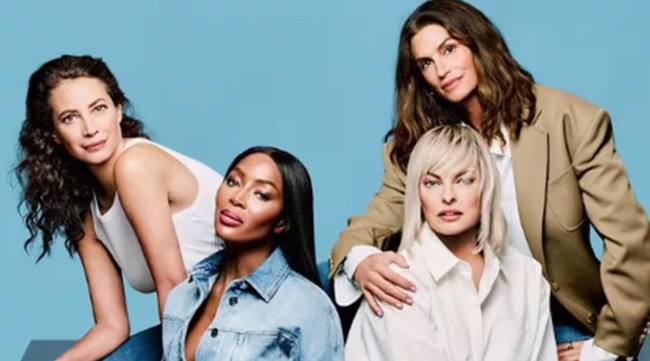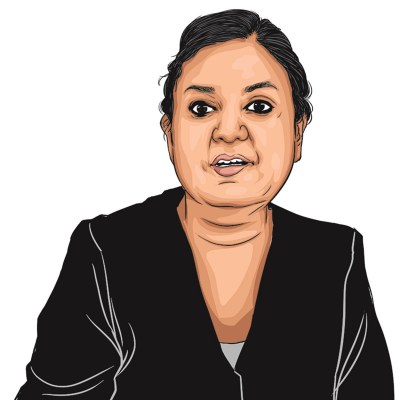Opinion Vogue reunion for Cindy Crawford, Naomi Campbell: The supermodels who showed us ordinary womanhood are back on the cover
At a time when celebrities went into hiding, they faced the flashbulbs and questions, no jacket required
 Unlike assembly line models today, they refused to be clones of male fantasy and became a brand with a recall so strong that even the fickle world of fashion craved permanence through them. (Source: Vogue/ Instagram)
Unlike assembly line models today, they refused to be clones of male fantasy and became a brand with a recall so strong that even the fickle world of fashion craved permanence through them. (Source: Vogue/ Instagram) When singer-songwriter George Michael wrote ‘Freedom! ’90‘, not as a woke statement but a writhing and anguished cry to end the war with himself to declare his sexuality, he didn’t want to do a music video. But MTV was the social media of its time and Michael was under pressure, though he didn’t want to appear as another wanted man in cool shades. So, he chose women to deconstruct the idea of himself as well as the pop culture that had legitimised the video over his music, physical beauty over the soul of the lyrics. He approached the five supermodels who had just appeared on the Vogue cover and had by then contoured the idea of aspiration and elitism by walking the ramp for every top fashion house in the world, even heaving down from billboards. Then he made them lip-sync to his vocals in biker streetwear. It was the Beatles moment for Cindy Crawford, Naomi Campbell, Linda Evangelista, Christy Turlington and Tatiana Patitz as they found a liberating grammar for themselves.
They had undone what they had become till then, desirable icons whom Evangelista said “wouldn’t wake up for less than $10,000 a day.” In a post-WTO world that celebrated consumerism, they had already embodied its markers. Crawford, who had upturned the idea of a black dress with the plunging red Versace number, was unabashed about being sexy. Turlington was classic elegance, Evangelista a chameleon and a rebel with her changing hair colour and Campbell the wild one with her rivetting gaze. But with this song video, they gave up the statuesque perfection they attempted and became real, disrupting what was dictated to them and developing their own democratic idiom.
Evangelista wore a regular workman’s sweater, Campbell donned leather and biker boots, Turlington wrapped a linen sheet, while Crawford lay immersed in a bathtub, her head above water. It was then that they became self-accepting. Subsequently, they gave up crafted vanity and owned the ramp with their unique “working girl” persona, built a sisterhood where they had each other’s back, fought for pay parity, dismantled ageism and seared us with a strong feminine spirit. Unlike assembly line models today, they refused to be clones of male fantasy and became a brand with a recall so strong that even the fickle world of fashion craved permanence through them.
And today, when they have moulted and warped around the edges a bit, these mid-50s women are still living life on their terms, still breaking boundaries. This is why Vogue is reuniting them after 33 years for their prized September issue in the US and UK, and Apple TV is airing a documentary which they have all co-produced. They haven’t let go of the agency they had wrested in 1990 with Campbell insisting that they tell their story their way as they are partners in the narrative of their legacy.
So how did the four (Patitz passed away in January) become a women’s collective of sorts?
Perhaps they didn’t do anything extraordinary though they fought individual battles and devised their own coping mechanisms. At a time when #MeToo wasn’t even allowed as a scribble, they avoided exploitation despite working with photographers who have since been accused of inappropriate behaviour with models. Crawford had the panache to pull off a nude pictorial at various points in her Playboy shoots but kept away from parties and needless socialising. Campbell fought racism, demanding a place beyond the ramp in ad campaigns, fighting an industry that had set exclusionary standards of beauty and becoming the first Black model on the French Vogue cover in 1988. In fact, she has never broken from the circuit, her lithe self gliding effortlessly through time, making people sit up during the recent Haute Couture Week in Paris, where she dared to don a wolf-head coat dress. Unknown to many, Evangelista relentlessly demanded higher rates for models.
All four have owned their frailties with aplomb and candour, be it Campbell with her drug rehab, Crawford with her admission to taking botox and vitamin injections and Evangelista by revealing how a botched fat-freezing treatment had left her body deformed. At a time when celebrities went into hiding, they faced the flashbulbs and questions, no jacket required. Nor did they choose to absolve themselves through staged confessionals on reality TV.
Unlike nowadays, when celebrities market pregnancy and motherhood to endorse the next superfood and maternity line, these women kept their motherhood a matter of personal choice, away from the arclights and normalised it as part of any working woman’s life. In October 2006, Evangelista did a cover shoot while pregnant, and gave birth to her son but refused to name the father until a legal suit necessitated it in 2011. Campbell chose her pace, becoming a single mother, once in 2021 and the second earlier this year, at 53, while still strutting the catwalk for Valentino. Post-motherhood, Crawford shot a series of home fitness videos called Shape Your Body, to help new mothers get back into shape, which became a cult fit for American women.
Nowadays, they are businesswomen and activists in their own right. Crawford lends herself to campaigns on leukaemia, having lost her brother to it. Campbell, who inspired the Disney character Pocahontas, is grooming the next generation of talent from emerging communities and Turlington is now a marathoner, her last outing being in 2021, apart from investments in ayurvedic skincare and yoga lines. Many would like to see them as battle-hardened superwomen but they never had that mission. All they did was live every shade of the evolving and adaptive nature of womanhood and put their point of view from a vantage point they have never let go of. Call them OG, ageless, timeless but they never cared much for labels. So when 30-year-old Rafael Pavarotti shot them in classic black, they decided to have fun with it, never minding the warts and wrinkles. Just another day at work, 18 or 58.
rinku.ghosh@expressindia.com





